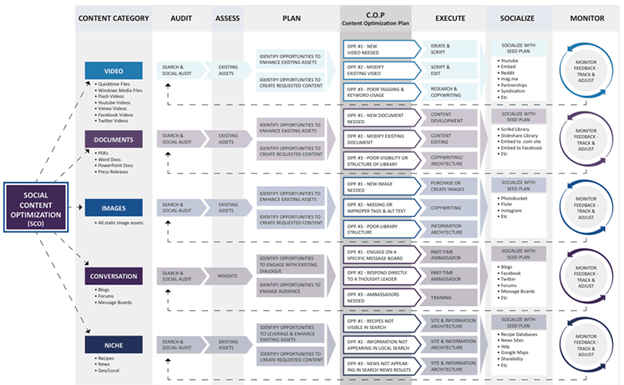What is Social Media Content Marketing? Tips and Tricks

Social media content marketing is the state where social media and content marketing meet. With an increasingly social B2B and connected online customer purchasing journey, the need for social content marketing strategies and tactics is growing. But it isn’t only about optimizing content for social media or social sharing. It’s also about connecting social collaboration, business and newsroom principles and techniques to content marketing.
In many social content marketing models, blogs are the content cores, and the social media channels are being used to publish content across connected costumers. However, a good content strategy is more complicated than that and also includes offline activities and websites. It doesn’t put the content (such as a blog) but the buying persona, customers or audience at the center, combined with the usual marketing goals.
Although, a social content plan makes sense as social media are essential in most content marketing purposes and vice versa. It also makes sense to look at various social content sub-strategies, adapted to the different social media channels. Many businesses use all social media channels the same way: sharing content in a non-optimized and fast way.
Social content optimization and strategies
With using social media content optimization, the impression of content shared via different social media channels and depending on the inherent features of each social platform, depending on your target audiences. Segmentation and an optimized social content strategy usually beat the one-size-fits-all method many companies use to get their content shared. Developing content and a content strategy for, for example, LinkedIn, will lead to far better outcomes by taking the behavior of the users of the channel and how they use the content.
Eventually, social content marketing attaches the social collaboration and support dimensions to the content workflows and involvement of the whole ecosystem (employees, audiences). So often involves using social newsrooms or command centers to create a loop between content production and social input.

Typically a social content strategy:
- Analyzes how target audiences and individuals use different social platforms to find information.
- Looks at how user-generated content and social media content can be combined to provide more value.
- Has an integrated social strategy whereby the different social channels extend each other while avoiding marketing exhaustion or message overkill.
- Is integrated with your overall content marketing strategy.
- Includes a schedule per social platform mixed with the editorial calendar, or on top of it, that outlines the content, target audiences, and KPIs.
- Is connected with an automation platform and social media platforms so potential customers can be followed up as social media automatically.
- Goes far beyond the simple sharing of content: monitoring, listening and knowing what target audiences are talking about or what they want, should lead to the production of content responding to their needs.
These are just a few of the leading social content marketing strategies that you can use.
More tips and tricks:
- Social content optimization, whereby the social platforms look upon as media themselves and the genuine sharing of content recognized as the creation of content within a broader context requires little work that can result in high result. A tweet, for example, can be approached as a social object and a contextual piece of content as such.
- Analysis and development using a mixture of social media platforms, analytics, CRM and automation tools allow you to examine the influence of your content across your social connections. Besides, it’s essential to observe and monitor how your social content progresses and how the social engagements of your target audiences can improve your content marketing.

Often used social tools and channels in a social content context are:
- Owned media including blogs.
- Usual suspects like Twitter, YouTube, Google+, LinkedIn, etc.
- Social automation platforms.
- Pinterest and consumer-oriented bookmarking platforms.
- Social collaboration tools.
- Social and collaboration allowed extranets, intranets and information administration solutions.
The list is much longer in fact, but it’s better to focus on those platforms your audiences use first, and experiment on platforms with low risk and high potential ROI.
source: https://il.ink/blog/social-media/what-is-social-media-content-marketing-tips-and-tricks/